White Garden Ideas: Simple Elegance and Effortless Beauty
Something catches your eye. A soft glow. Not from a lamp. From the flowers themselves. Ghostly white petals shimmer under the moon. They almost seem to float in the dim light. Pure, silent, breathtaking beauty. This is the unique power of a white garden.
White gardens possess a timeless appeal. They feel deeply serene, instantly calming. And look incredibly elegant, effortlessly chic. Best of all? They work almost anywhere. You can create this magic on a tiny balcony. Or design a vast, sprawling white landscape. Our white gardens ideas are adaptable, fitting any space you have..
[ez-toc}
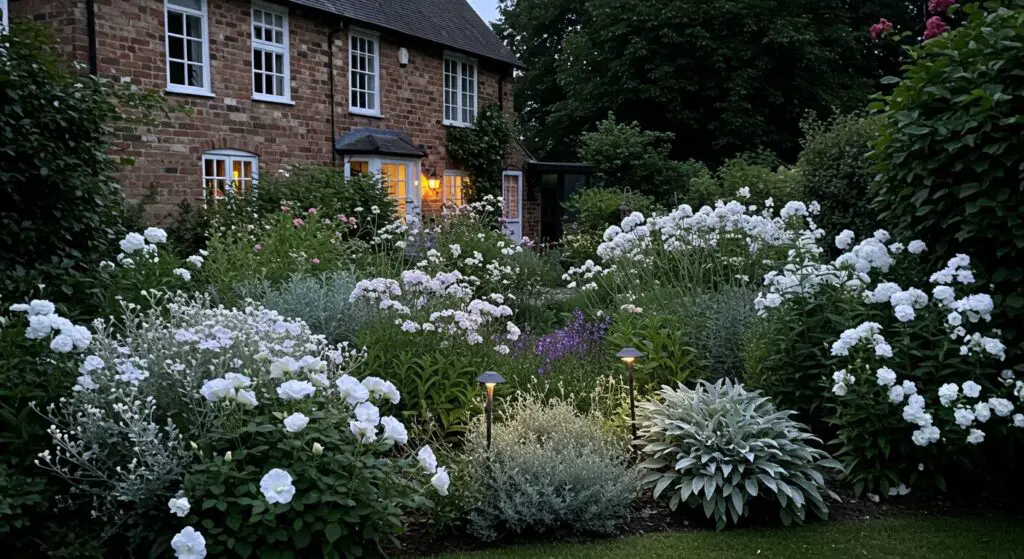
Anyone can create a beautiful white garden. You don’t need years of experience. Beginners find them simple to start. Expert gardeners love the sophisticated challenge. We focus on white gardens design that values simplicity. Looks matter, of course. But we also think about sustainability. Growing a gorgeous garden shouldn’t be complicated. It should bring you peace. And beauty.
Understanding the White Gardens Aesthetic
What exactly makes a white garden feel so special? The white gardens aesthetic is all about creating a feeling. It’s peaceful. It looks bright, even on cloudy days. And it feels very refined. Using mostly one color might sound boring. But it’s not. A limited palette forces you to play with other elements. You notice texture more. Shape becomes important.
Different shades of white add subtle depth. Think creamy whites, pure whites, and whites with hints of green or pink. Combine these with the many shades of green from leaves. The result is rich and interesting. Some gardens use only white flowers and silvery foliage. Others use white flowers as bright accents against a backdrop of green shrubs or dark foliage. White can be the star, or it can be a supporting player.
There’s history here too. Vita Sackville-West created a famous White Garden at Sissinghurst Castle in England. Her garden is still a huge source of white gardens design inspiration today. It shows how powerful a single color focus can be. It feels both classic and fresh.
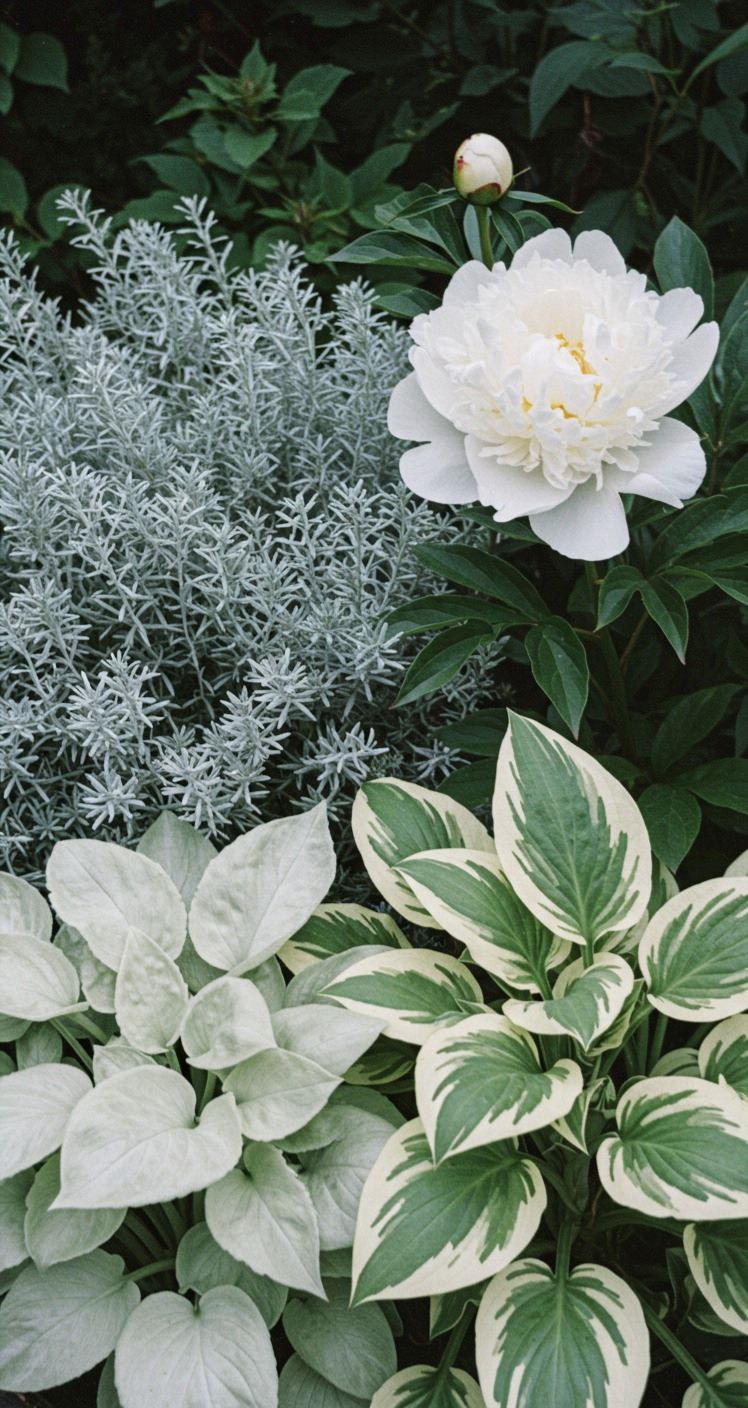
Design Principles for Creating Simple White Gardens
Designing a white garden is like painting with light. You use white blooms and foliage to create mood and structure. Some simple principles help make it stunning without being difficult.
Color Coordination
White is your main color, your foundation. But pure white everywhere can feel flat. Use different shades of white for depth. Creamy ivories, pure snow whites, maybe some with a blush of pink or green. Green foliage is your best friend. It provides the perfect backdrop. Dark green leaves make white flowers pop. Silvery-green foliage adds shimmer. Also think about your hardscaping – paths, benches, pots. Neutral colors like gray stone, warm wood, or terracotta work beautifully. They complement the white without competing.
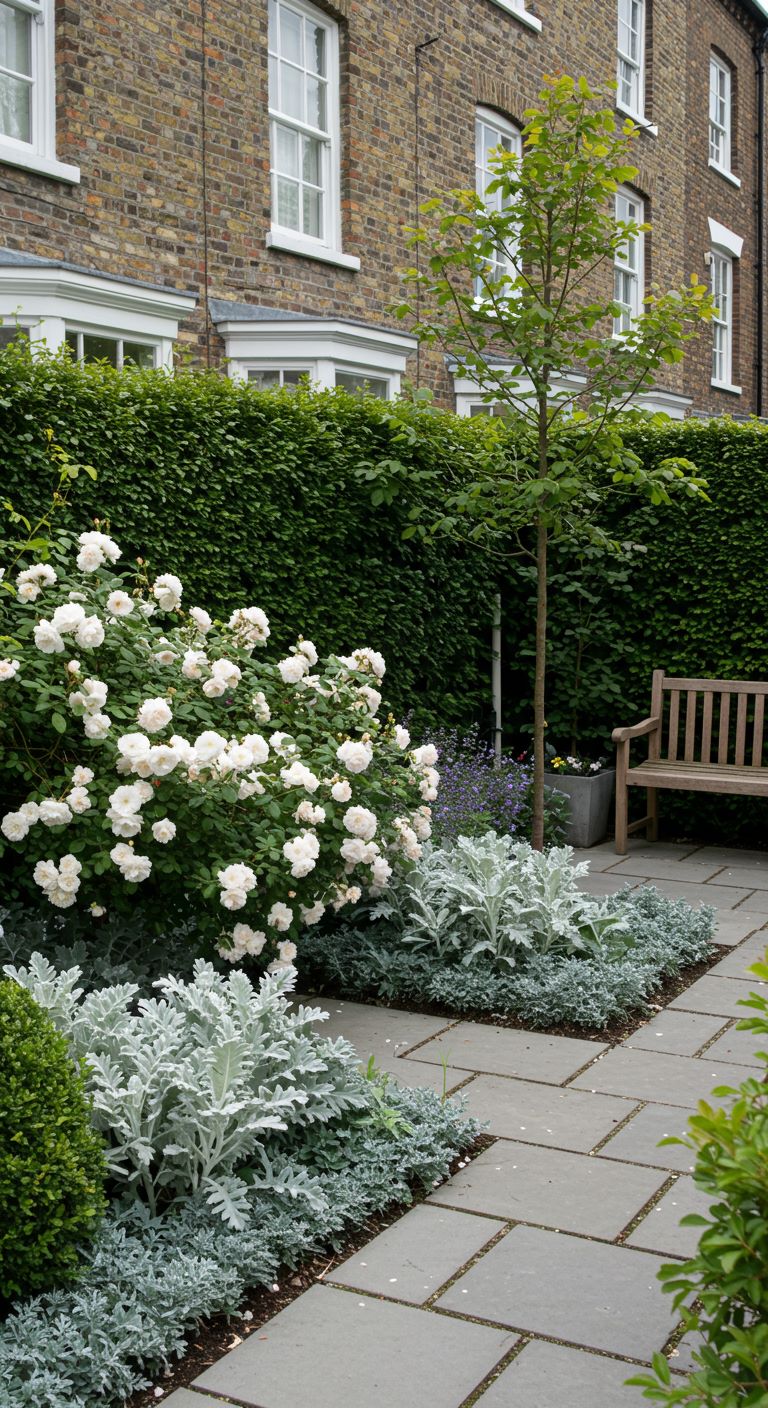
Texture Play
Texture keeps a single-color garden interesting. You want variety. Mix plants with big, bold leaves next to ones with fine, feathery foliage. Think about flower shapes too. Combine spiky blooms like white Salvia with rounded flower heads like Hydrangeas. Contrast delicate, airy flowers like Baby’s Breath (Gypsophila) with the solid presence of white Coneflowers (Echinacea). Different textures catch light differently. They create shadows and highlights. This adds depth and stops the garden looking one-dimensional. Even the bark of shrubs or the surface of stepping stones adds texture.
Form and Structure
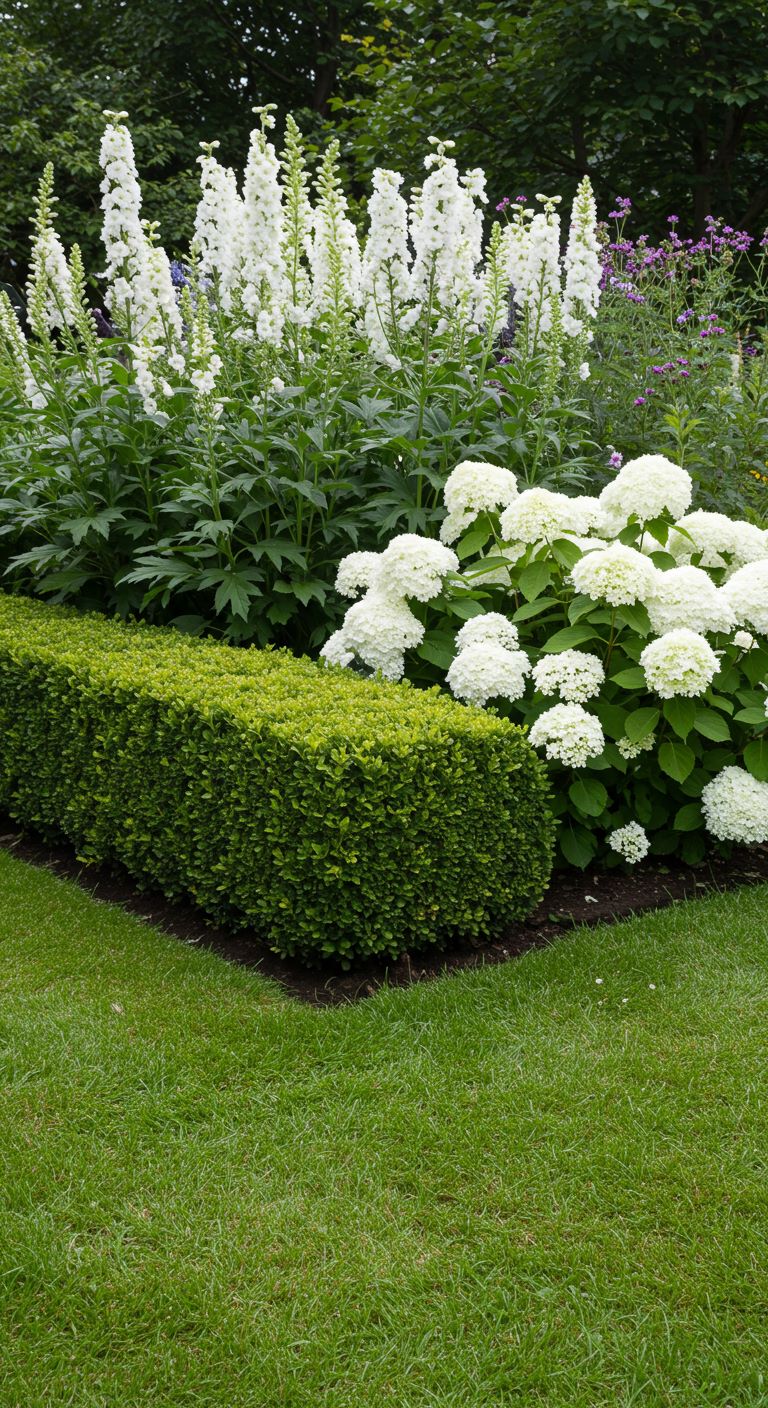
Form refers to the shapes of your plants and garden features. Structure is the backbone – the permanent elements. Use plants with strong shapes. Think tall, upright grasses or neatly clipped boxwood spheres. These architectural plants provide definition year-round. Clean lines in pathways or raised beds give a modern feel. But softer, mounding shapes create a more relaxed atmosphere. Balance structured elements with looser plantings. An archway covered in white climbing roses adds vertical interest and a sense of enclosure. Good structure ensures the garden looks good even when not everything is blooming.
Lighting Considerations
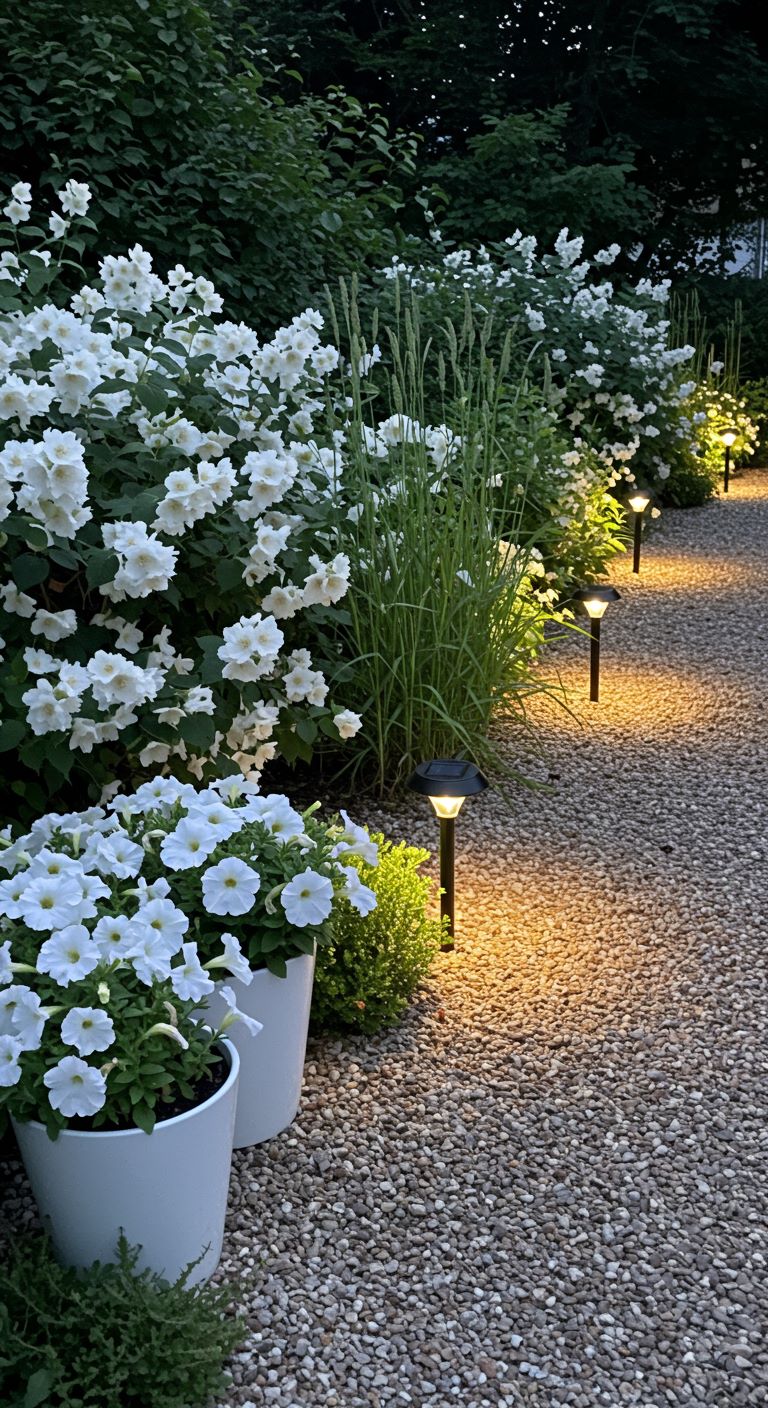
White gardens truly shine at certain times of day. They look amazing in the soft light of early morning or late afternoon. And they are magical at night. White flowers seem to glow in twilight and under moonlight. Place white plants where they will catch the evening sun or reflected light from a nearby wall. Think about outdoor lighting too. Uplighting a small tree with white bark, like a Birch, looks fantastic. Soft path lights or lanterns can guide the way and highlight key planting areas after dark. The way light interacts with the white elements is a key part of the design.
Seasonal Interest
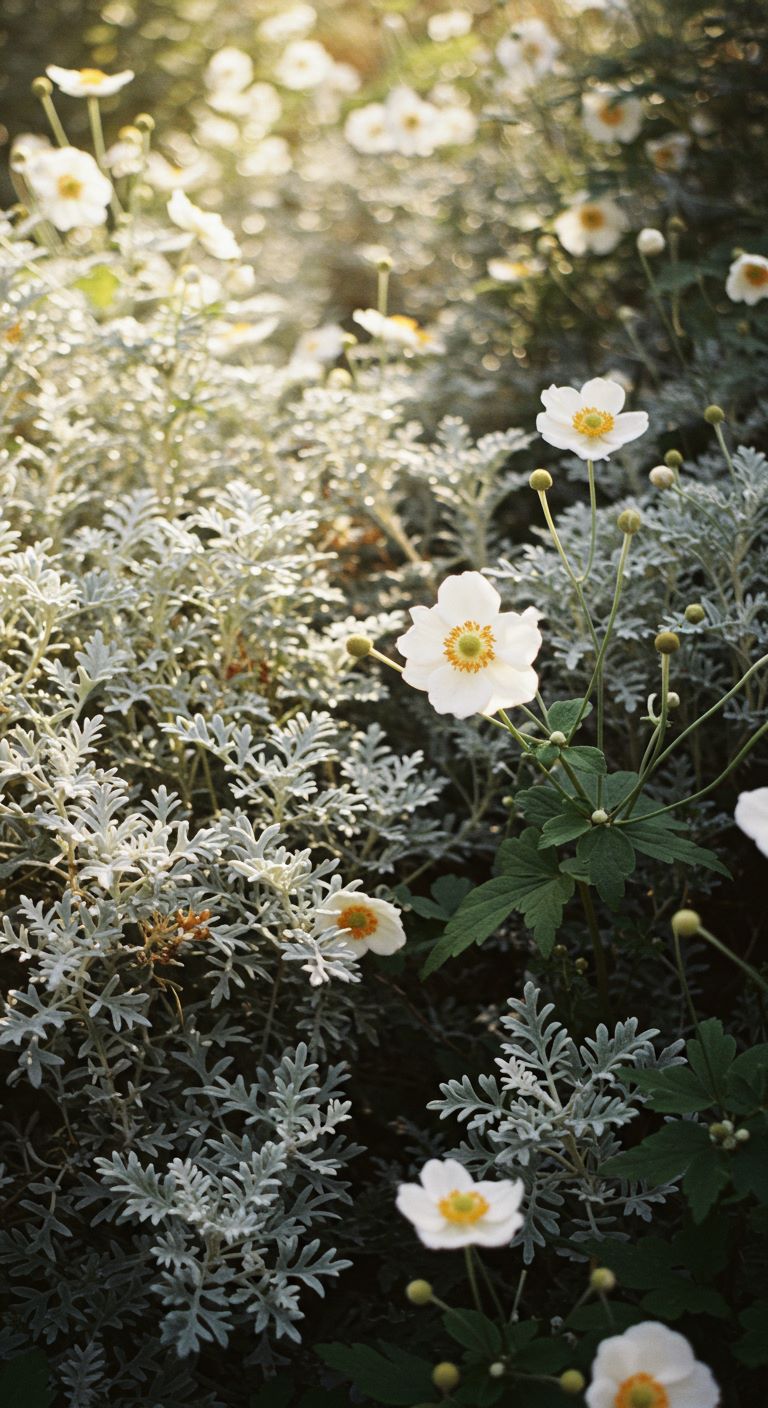
A great garden offers something beautiful in every season. Plan your white garden for continuous interest. Choose plants that bloom at different times. Start with spring bulbs like white Tulips and Daffodils. Move into early summer peonies and irises. Mid-summer brings Hydrangeas, Phlox, and Shasta Daisies. Late summer and fall offer Japanese Anemones and white Asters. Don’t forget foliage. Plants with white or silver leaves, like Dusty Miller or variegated Hostas, look good all season. Evergreen shrubs provide structure in winter, especially if dusted with snow.
Choosing Low-Maintenance Plants for White Gardens Landscaping
You want beauty without constant fuss, right? Choosing the right plants is key. Focus on low-maintenance plants. These are tough, resilient varieties. They handle various conditions well. And they don’t need endless pampering. Luckily, many wonderful white-flowering plants fit this description. Your white garden can be easy and elegant.
Recommended Easy-Care White Plants
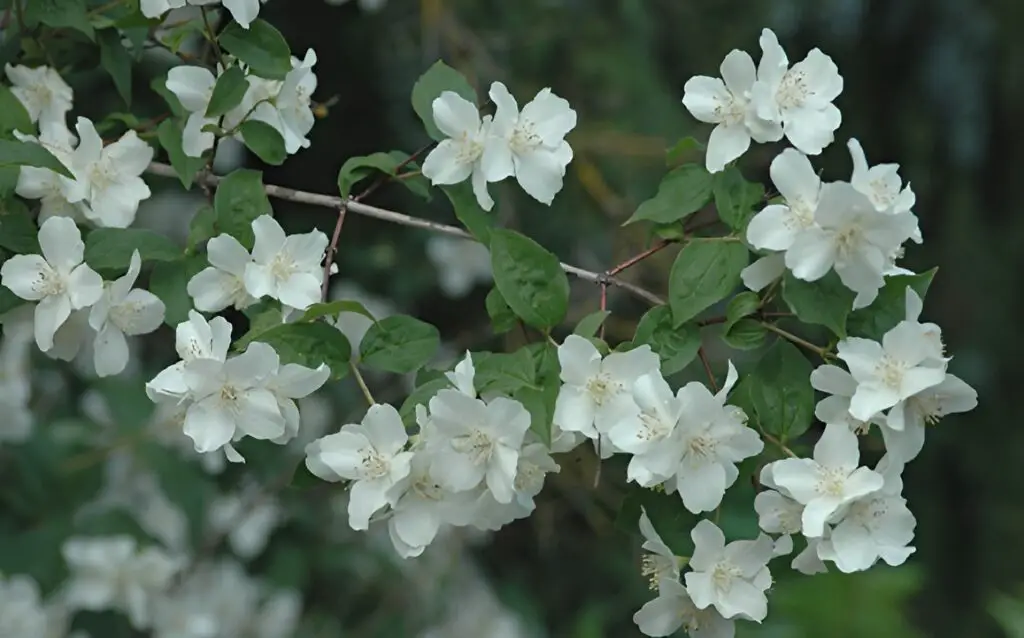
Here are some reliable choices for white gardens landscaping:
Shrubs:
- White Hydrangeas: Many varieties exist. ‘Annabelle’ is famous for huge round flower heads. Panicle hydrangeas like ‘Limelight’ (starts green, turns white) are super hardy. They offer big impact for little work.
- Gardenias: Known for amazing fragrance. Some newer types are more cold-hardy. They like acidic soil. Glossy green leaves look great too.
- Mock Orange (Philadelphus): Smells heavenly when blooming in late spring. Very tough shrubs. Many sizes are available. Prune after flowering.
Perennials (Come back year after year):
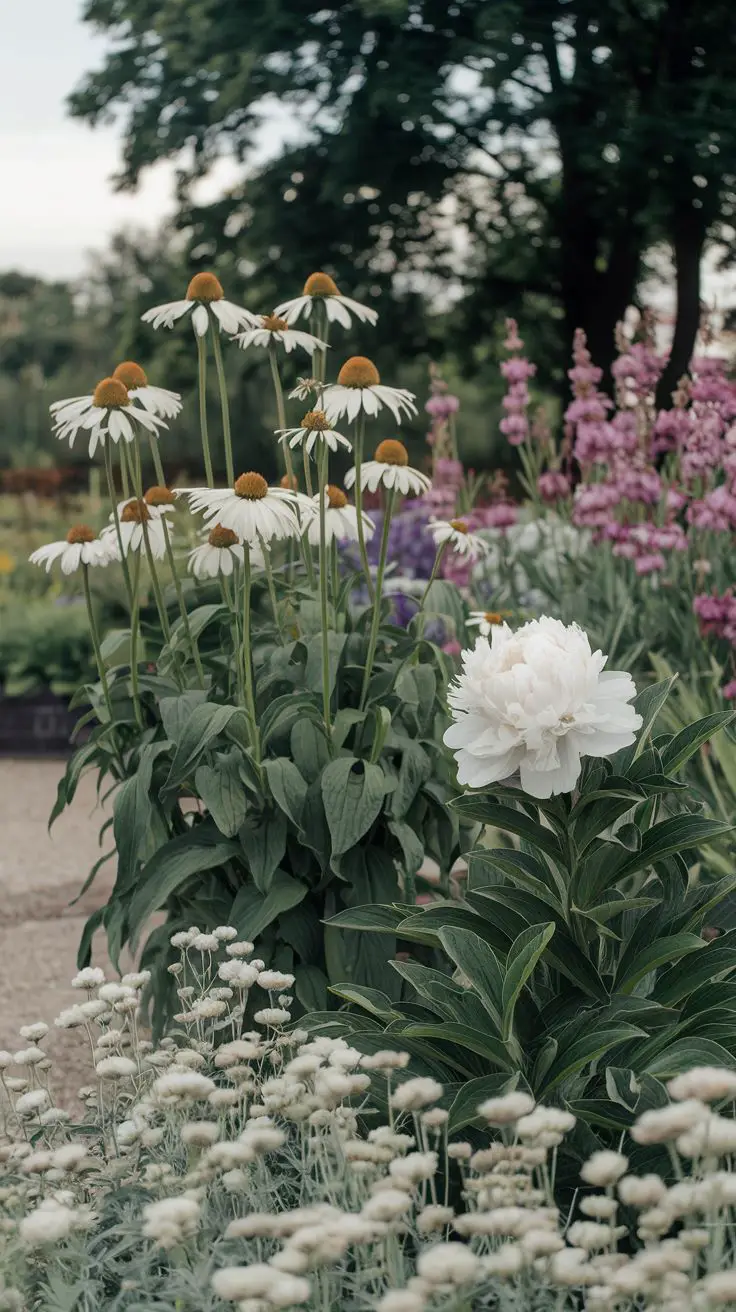
- White Coneflowers (Echinacea): Varieties like ‘White Swan’ are sturdy. They love sun and tolerate drought once established. Great for pollinators.
- Peonies: Old-fashioned favorites. White varieties like ‘Festiva Maxima’ are stunning. Plant them shallowly in a sunny spot. They live for decades.
- Lamb’s Ear (Stachys byzantina): Grown mostly for its fuzzy, silver foliage. Some types have white flower spikes. Very drought tolerant. Great edging plant.
Annuals (Live for one season):
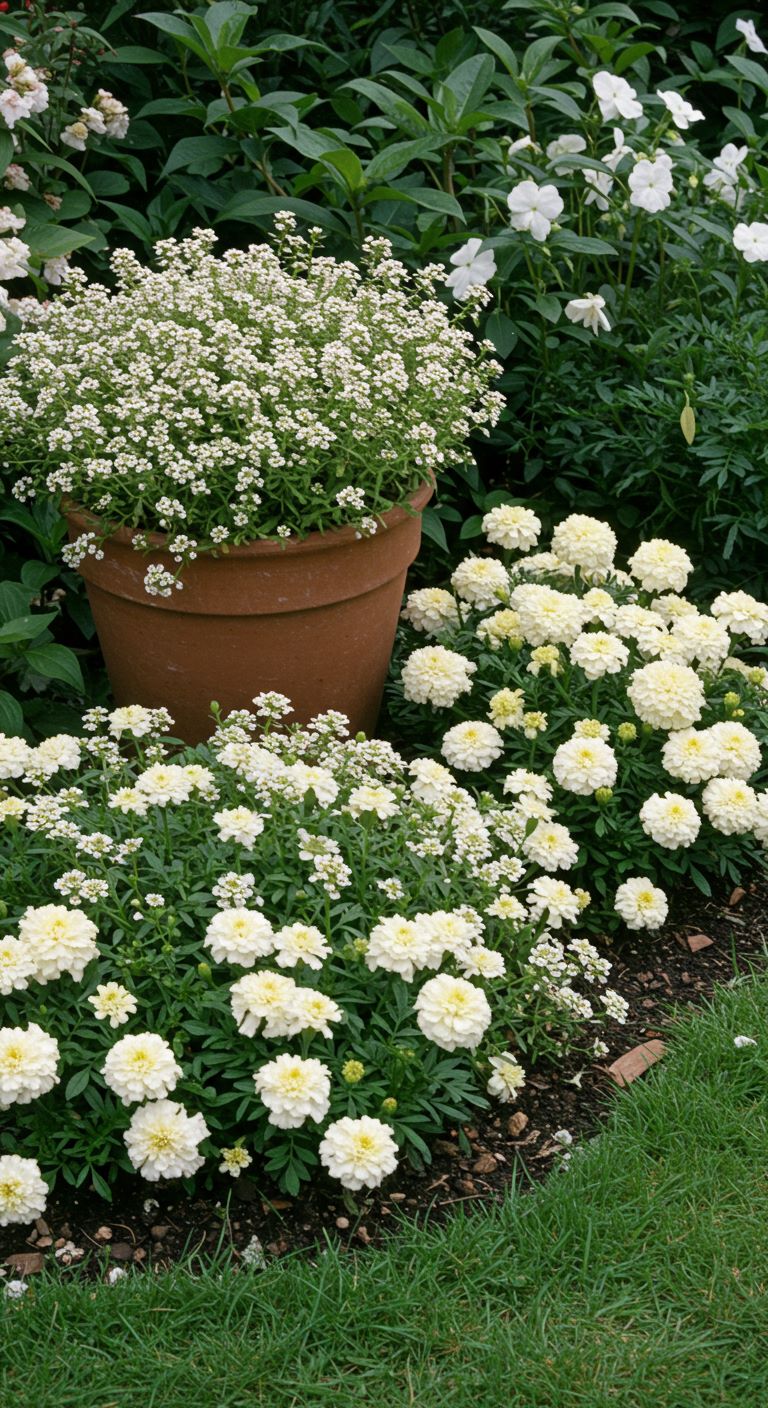
- White Marigolds: Some newer varieties are creamy white. Very easy to grow from seed. Tolerate heat well.
- Sweet Alyssum: Tiny white flowers form a dense mat. Smells sweet like honey. Great for borders, pots, or spilling over walls. Reseeds easily.
- Impatiens: Perfect for shady spots. Provide masses of white flowers all summer. Need regular water. ‘Beacon White’ resists downy mildew.
Foliage Friends and Finishing Touches
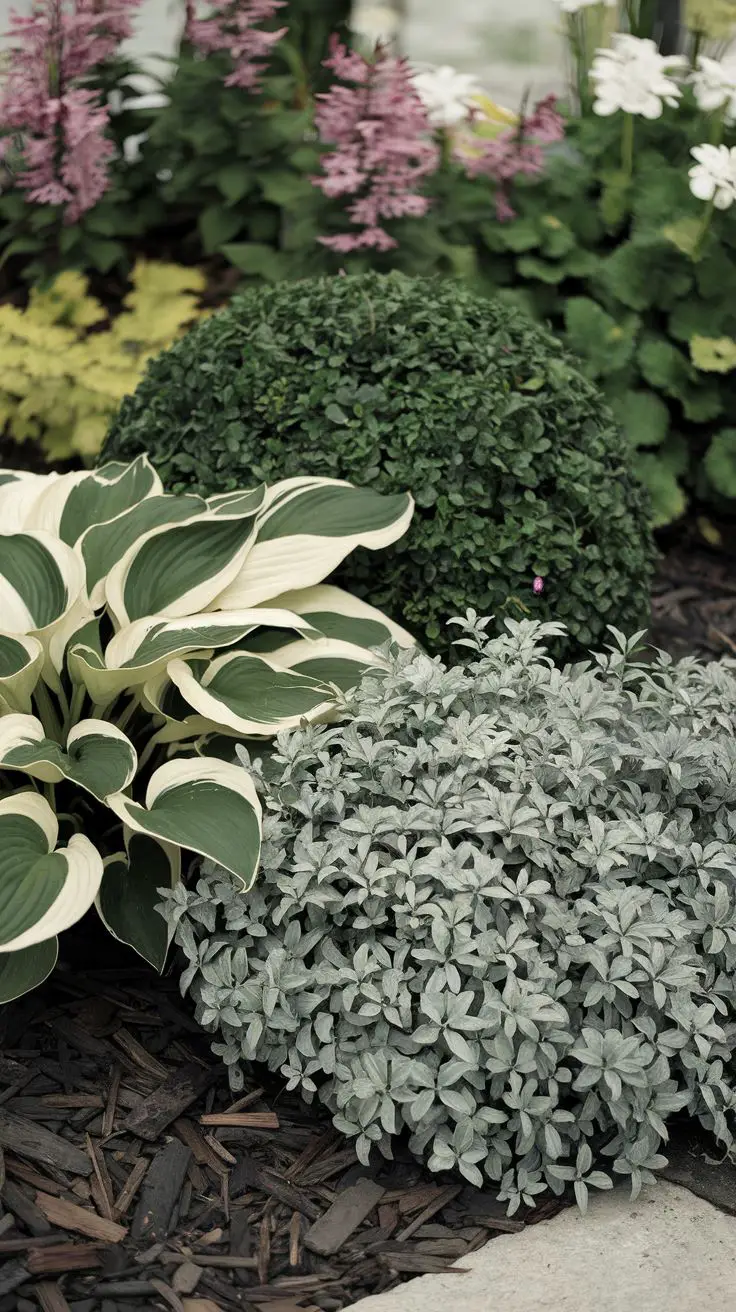
Don’t forget leaves! Plants grown for foliage add contrast and year-round interest.
- White-Variegated Hostas: So many patterns exist! Look for varieties with crisp white edges or centers. Perfect for shade. Slugs can be a pest sometimes.
- Silver-leaved Plants: Artemisia ‘Silver Mound’, Dusty Miller, or Russian Sage (has blue flowers but silvery leaves) add shimmer. They often love sun and tolerate dry conditions.
Pair these plants with evergreen structures. Boxwood, yew, or small conifers provide a green background. They make the white flowers stand out more. Use a neutral-colored mulch like dark brown bark chips or grey gravel. Mulch helps keep weeds down and moisture in. It gives the garden a neat, polished look.
Creative White Gardens Ideas for Different Spaces
A white garden theme works anywhere. Your space limitations don’t matter. You can adapt the concept beautifully. From tiny balconies to sprawling backyards. Let’s explore some ideas.
Small White Gardens
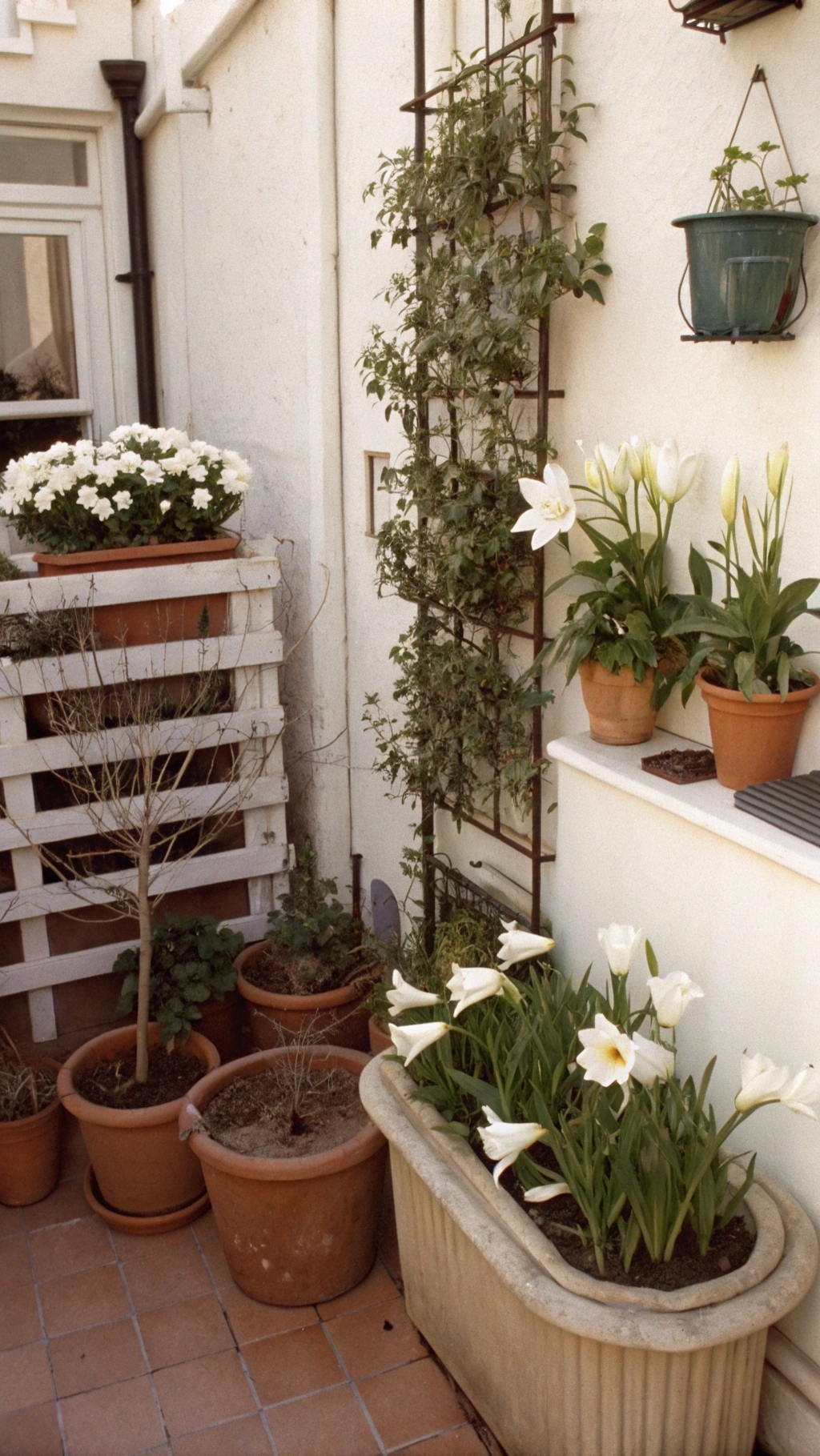
Got a patio, balcony, or tiny yard? No problem! Container gardening is your answer.
- Fill pots with layers of white bulbs: tulips, daffodils, hyacinths for spring.
- Use large containers for dramatic white lilies or compact hydrangeas.
- Plant trailing white lobelia or sweet alyssum to spill over edges.
- Try vertical planters. Wall-mounted pockets or tiered stands save floor space. Fill them with white impatiens (shade) or petunias (sun).
Rustic White Gardens
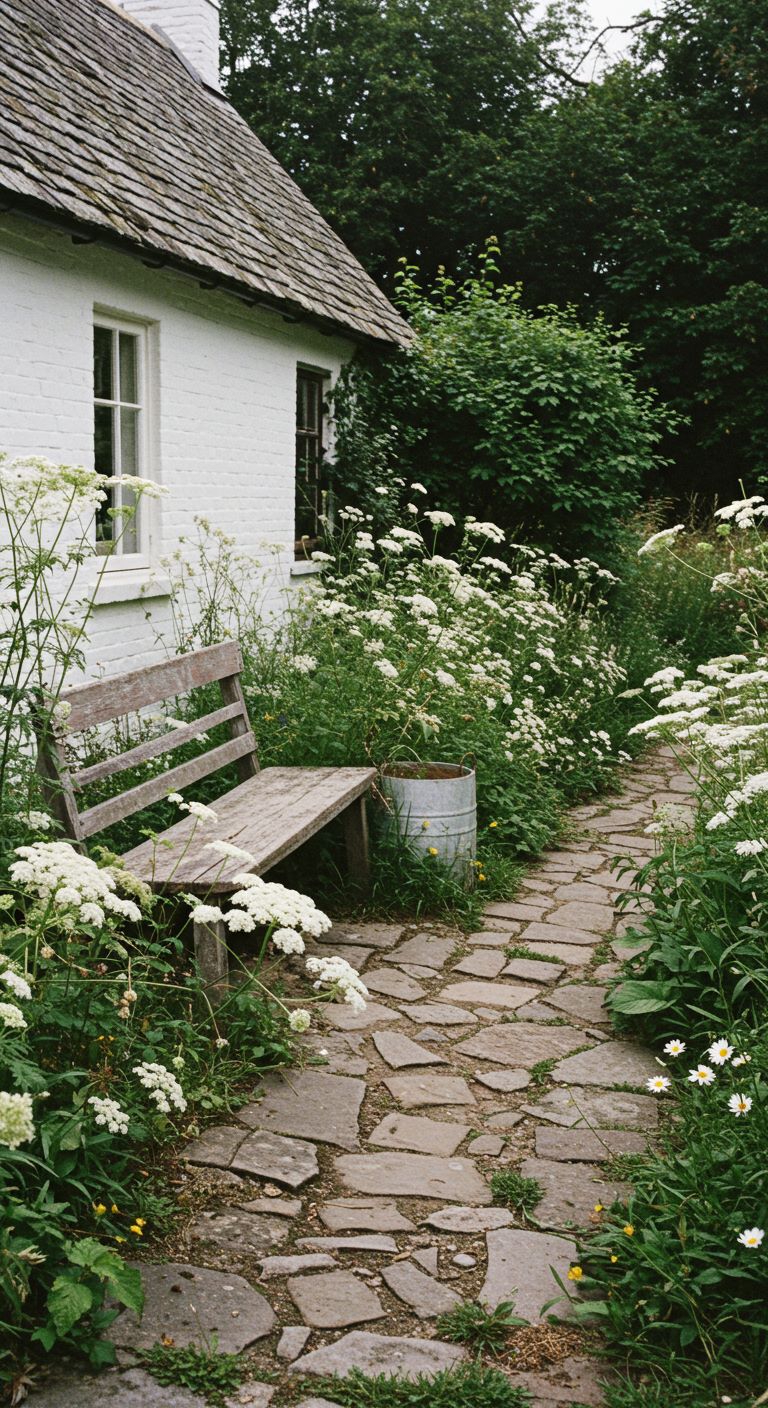
Love a more natural, relaxed feel? Create a rustic white garden.
- Use native white flowers. Think Queen Anne’s Lace, white asters, or Culver’s root (Veronicastrum). These support local wildlife.
- Incorporate reclaimed wood. Use old barn wood for raised beds. Or build a simple bench from weathered timber.
- Allow plants to self-seed a bit. Let things look slightly untamed. Think meadows, not formal borders.
- Use natural stone for pathways or edging.
Modern White Gardens
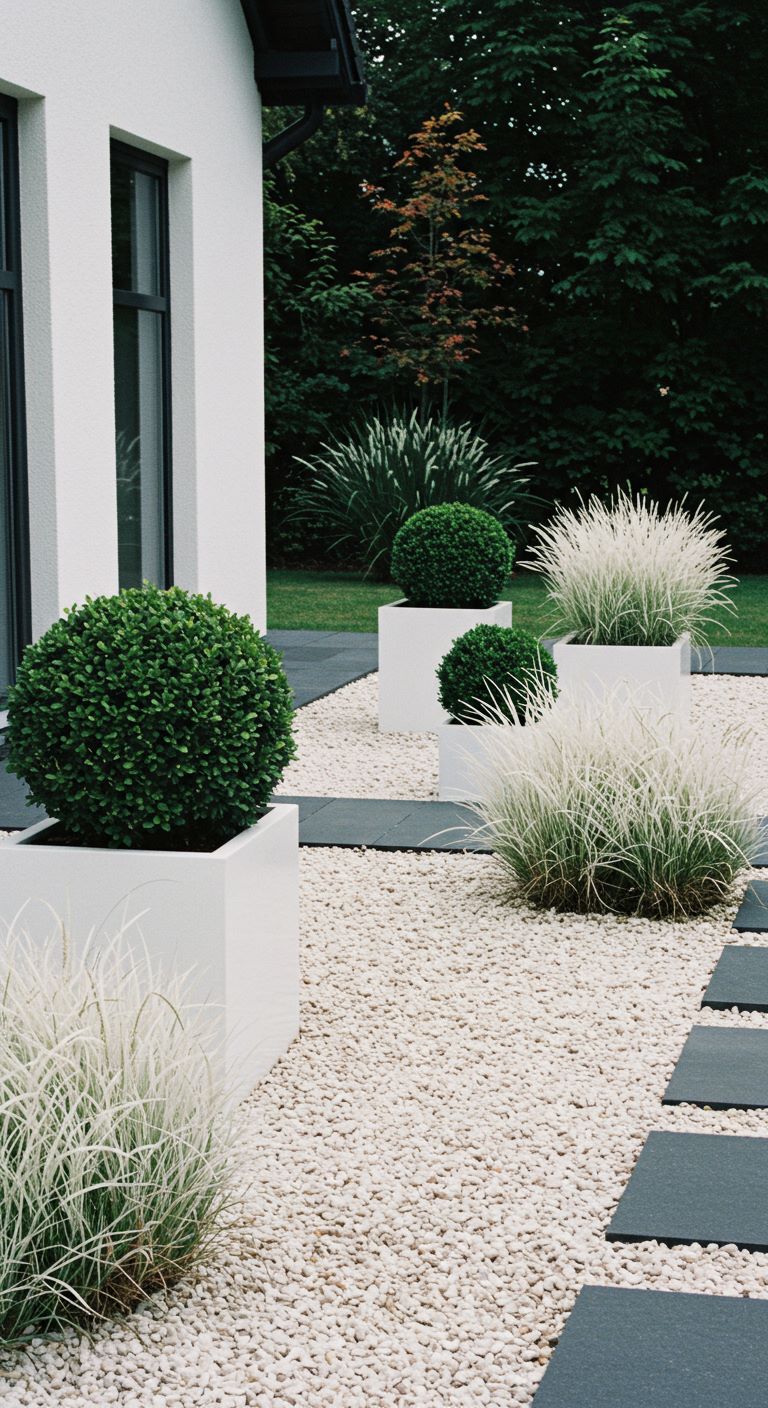
Prefer clean lines and a contemporary look? Go modern.
- Focus on minimalist layouts. Use strong geometric shapes for beds and paths.
- Choose plants with bold forms: architectural grasses, smooth hostas, clipped spheres.
- Limit the number of plant varieties. Repeat key plants for rhythm.
- Use sleek hardscaping. Think smooth concrete pavers, white gravel paths, or simple metal planters. Keep ornamentation minimal.
Outdoor Gardens Design White: Living Spaces
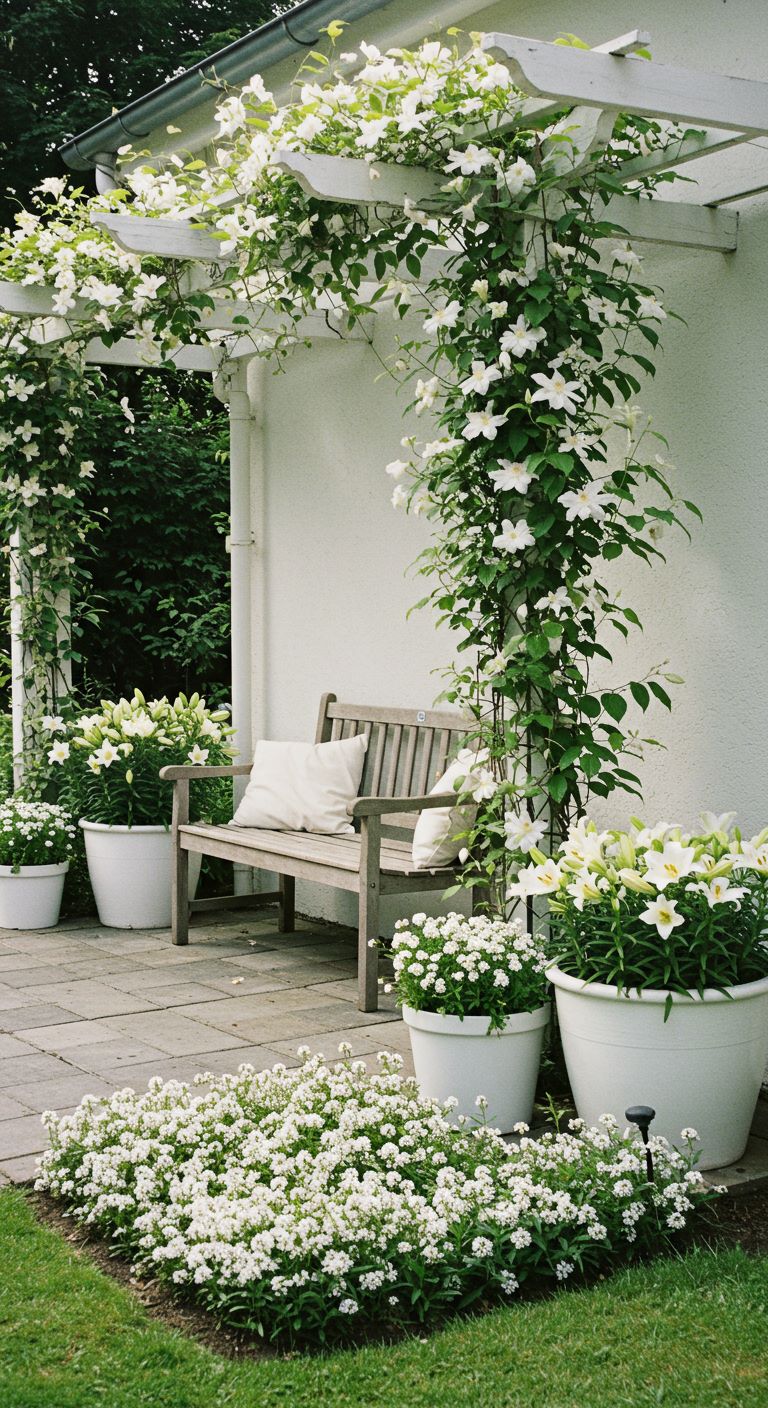
Integrate your white garden with outdoor living areas.
- Surround a seating area with fragrant white blooms. Gardenias near a bench offer scent. White roses climbing a pergola create romance.
- Use low white-flowering borders to define patio edges.
- Plant a small flowering tree with white blossoms (like Dogwood or Serviceberry) as a focal point near a dining spot.
- Cover trellises or walls near seating with white jasmine or clematis. Their scent enhances the experience.
Feel free to mix formal elements (like a clipped hedge) with informal plantings (like loose perennials). This keeps the space inviting. It feels structured but not stiff. The goal is a beautiful, usable outdoor room.
Accessible and Sustainable Practices in White Gardens Landscapes
Creating a beautiful white garden can also be kind to the planet. Sustainable practices make your garden easier to care for too. Accessibility means making choices that work for your abilities and resources. Let’s combine beauty with responsibility.
Eco-Friendly Plant Choices and Materials
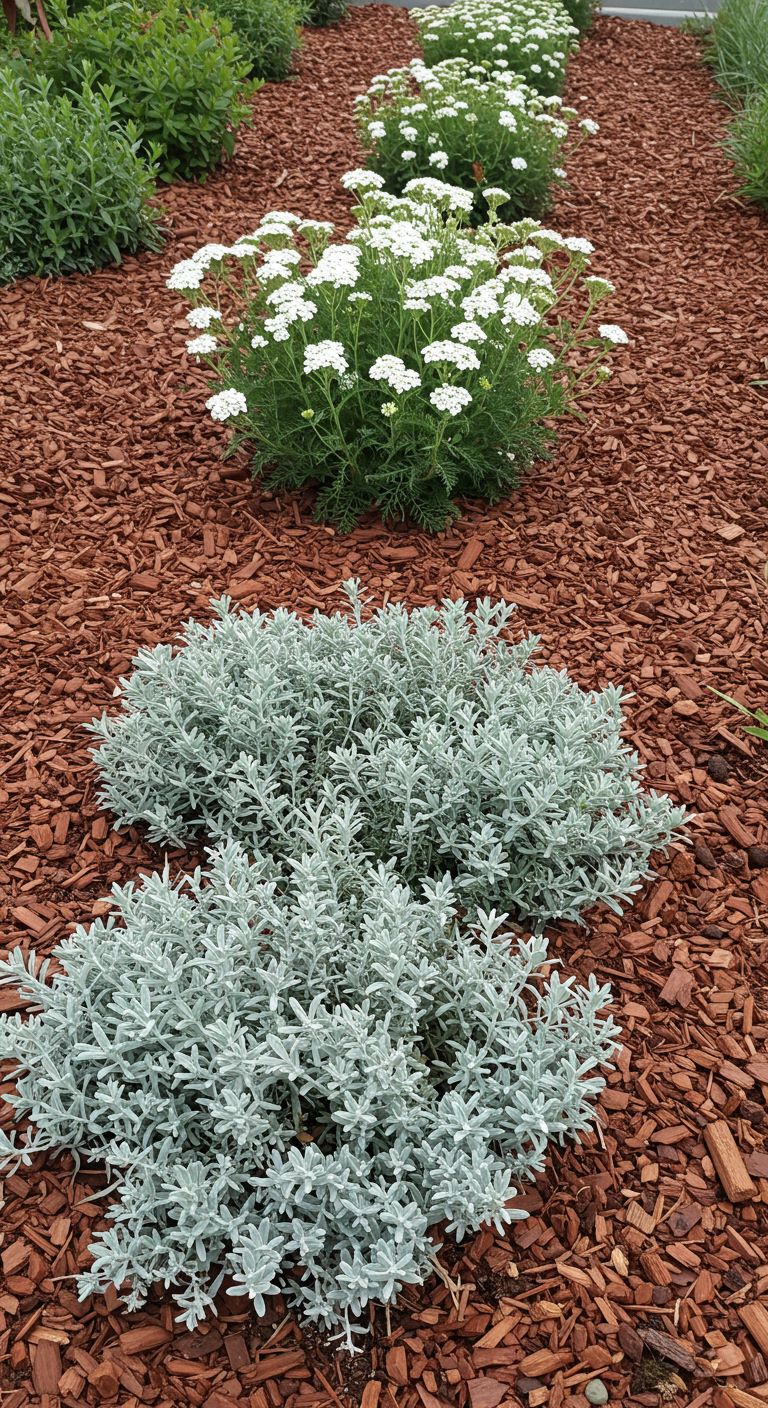
Choose plants suited to your local climate and soil. Native plants are often a great choice. They usually need less water and fertilizer. Select drought-tolerant plants for sunny, dry spots. White-flowering options like yarrow, catmint (Nepeta), or ice plant work well. Use organic mulches like bark chips, shredded leaves, or compost. Mulch conserves water, suppresses weeds, and improves the soil as it breaks down. Avoid plastic weed barriers; they harm soil health over time.
Smart Watering and Soil Care
Water wisely. Group plants with similar water needs together. This avoids overwatering some plants while others stay thirsty. Consider a drip irrigation system or soaker hoses. They deliver water directly to the roots, reducing waste. Water early in the morning to minimize evaporation. Healthy soil grows healthy plants. Improve your soil by adding compost regularly. Compost boosts nutrients and improves water retention. Avoid chemical fertilizers and pesticides whenever possible. Healthy soil encourages beneficial microbes and insects.
Attracting Beneficial Wildlife
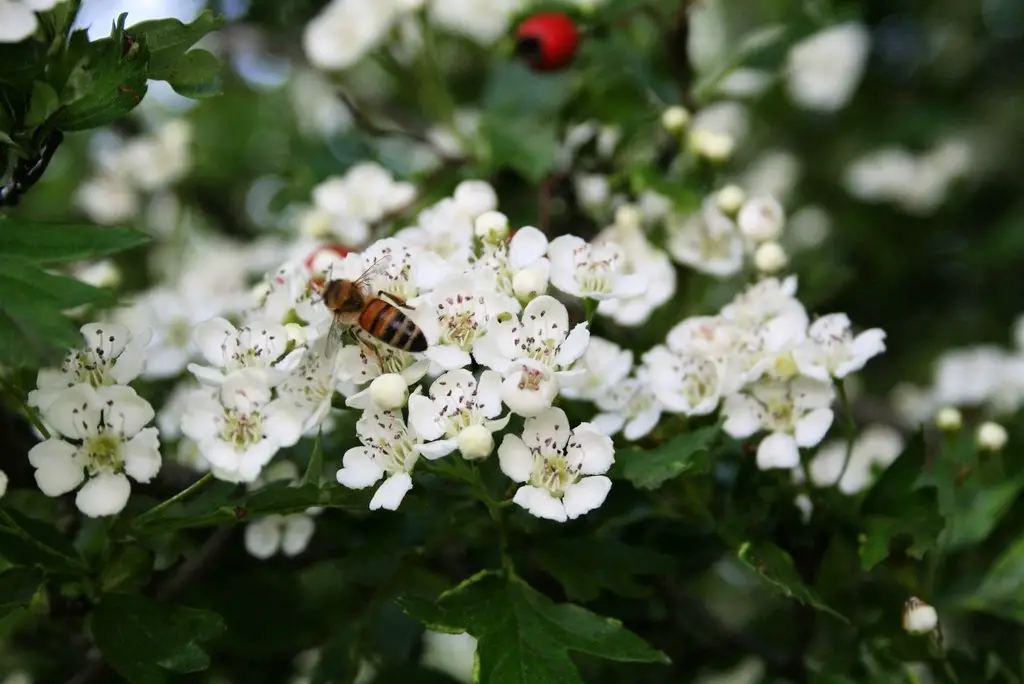
Your white garden can be a haven for wildlife. Many white flowers attract pollinators. Bees love white clover (let some grow in the lawn!), phlox, and milkweed. Butterflies are drawn to white lantana and buddleia (butterfly bush). Provide a water source, like a shallow birdbath. Include plants that offer shelter or food in winter, like shrubs with berries or grasses with seed heads. A balanced ecosystem helps manage pests naturally. Remember, a few nibbled leaves mean your garden is part of nature!
Styling Tips to Enhance the White Gardens Experience
Your plants are chosen. Your layout is planned. Now for the fun part: adding personality! Styling your white garden enhances its beauty. Little touches make a big difference. They tie everything together.
Hardscape Integration

Don’t forget the non-plant elements. Your paths, patios, and furniture matter.
- Use white gravel for pathways. It brightens shady areas and crunches nicely underfoot.
- Consider light grey stone pavers. They offer a cool contrast to green foliage.
- Paint wooden benches or chairs white. Or choose naturally light wood or metal furniture.
- White or pale grey pots and containers reinforce the color scheme.
Garden Ornaments
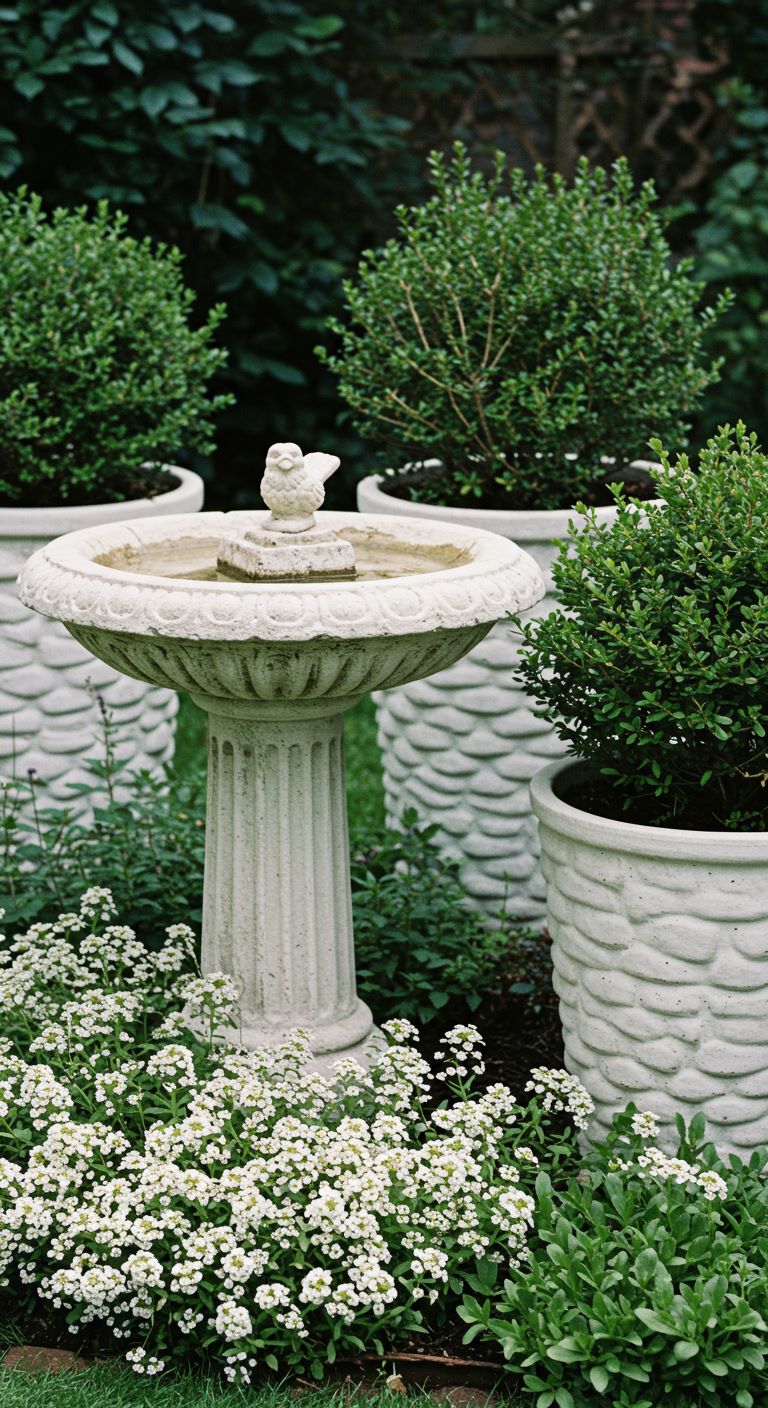
Add a touch of whimsy or elegance with ornaments. But don’t overdo it. Less is often more in a white garden.
- A simple white birdbath attracts feathered friends. It also reflects the sky.
- Place a classic statue or sculpture as a quiet focal point. Choose simple forms.
- White ceramic pots, perhaps with subtle textures, look sophisticated.
- A white birdhouse adds charm, especially against a green hedge.
Lighting Magic
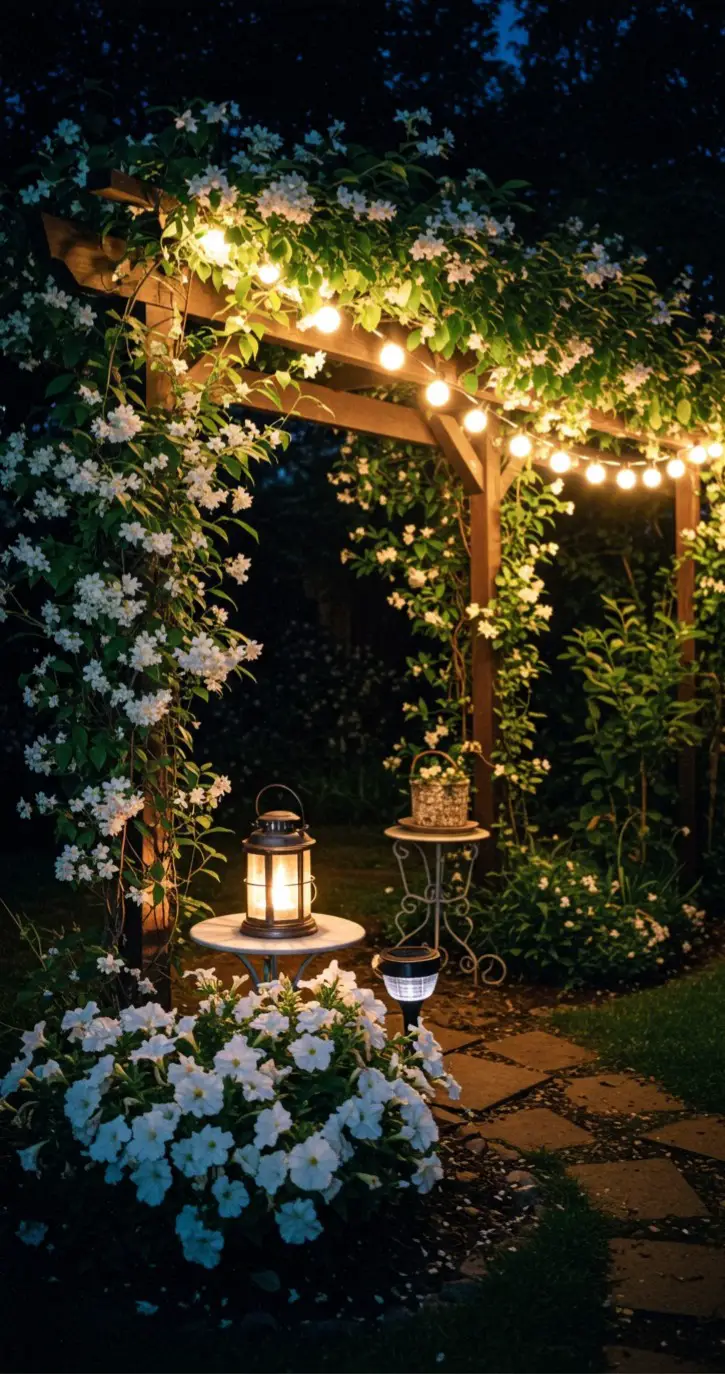
We talked about how white gardens glow at night. Enhance this with artificial lighting.
- Drape string lights through tree branches or along a fence. Warm white bulbs are best.
- Use solar-powered garden lights along pathways. They’re easy and energy-efficient.
- Place lanterns (with real candles or battery ones) on tables or steps.
- Uplight a special tree or architectural plant with a spotlight.
Focal Points
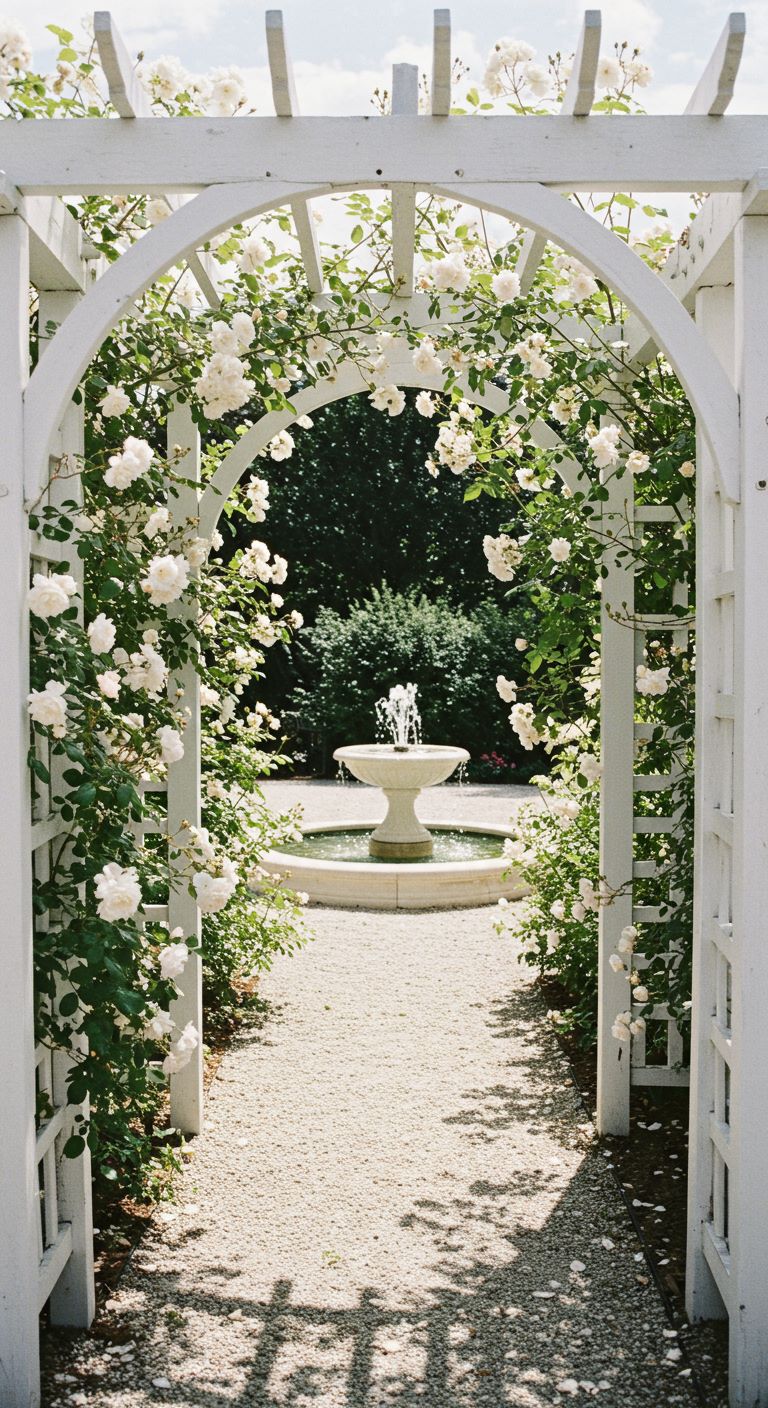
Every garden needs a place for the eye to rest. Focal points draw you in. They create visual anchors.
- An elegant arbor covered in white climbing roses makes a stunning entrance.
- A simple fountain adds soothing sound and movement. The water reflects light.
- Use a tall obelisk or tuteur for climbing plants like Clematis. Paint it white or grey.
- A single specimen plant with amazing form can be a focal point. Think of a weeping cherry with white blossoms.
Real-Life Inspiration: White Gardens Design Inspiration
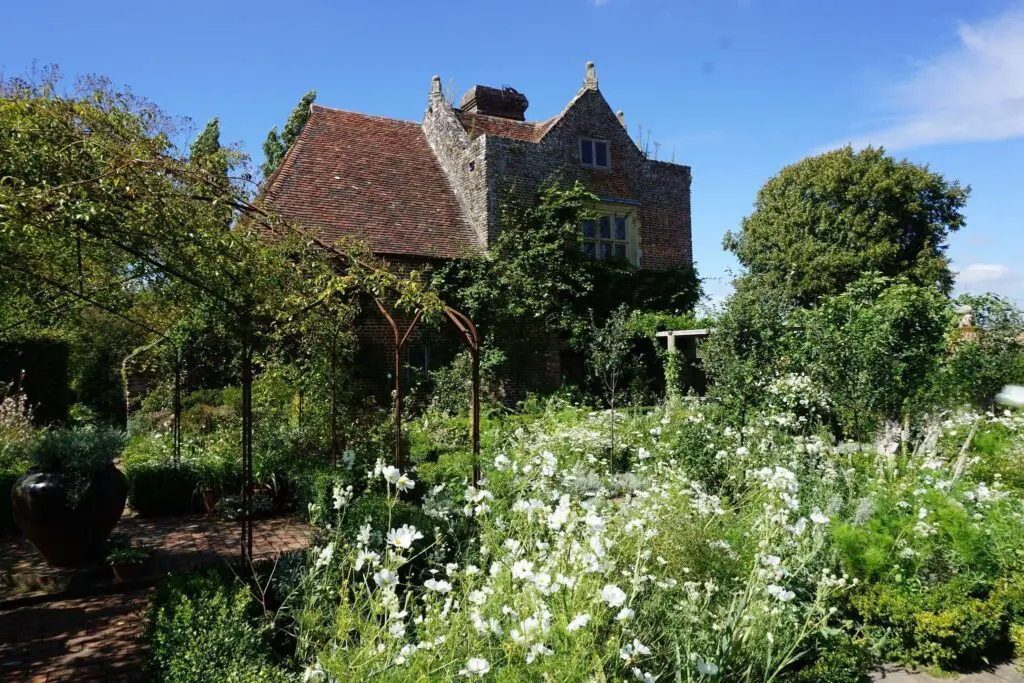
Need more ideas? Look around! Amazing white gardens exist worldwide. Seeing real examples sparks creativity. You can borrow ideas and adapt them. Find your own unique white gardens design inspiration.
Sissinghurst Castle Garden in England is perhaps the most famous. Vita Sackville-West’s creation is legendary. It shows how texture and form shine in a limited palette. Many botanical gardens have white sections or monochromatic displays. Visit one near you! Notice plant combinations and design choices.
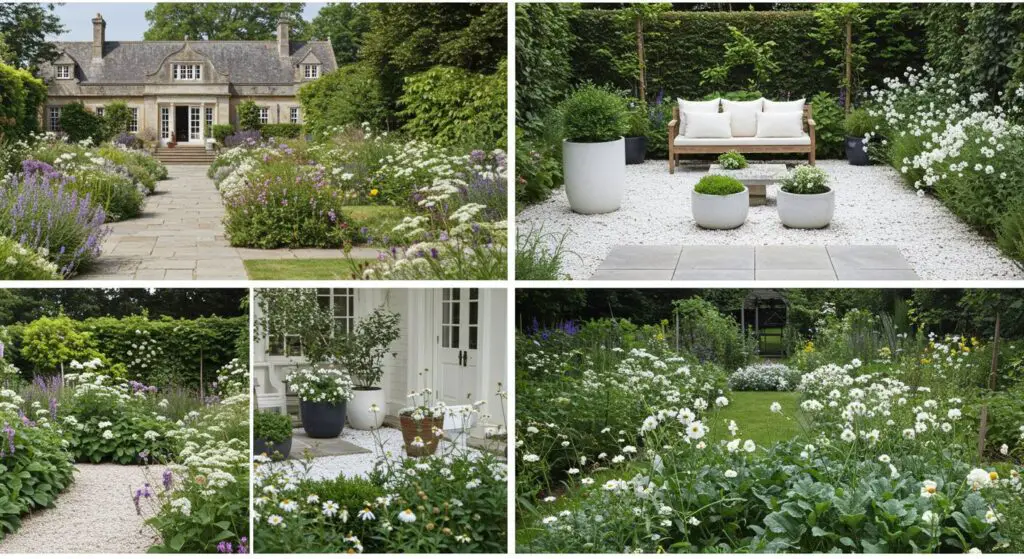
Look online too. Pinterest is filled with images. Search “white garden ideas” or “monochromatic garden”. You’ll find everything from tiny white balcony gardens to grand formal estates. See how others use hardscaping and ornaments. Notice different styles: modern, cottage, rustic. Some people even create all-white vegetable gardens! Using white flowers among the veggies looks surprisingly beautiful. White-themed gardens are also popular for weddings and special events. They create a romantic, elegant backdrop. Let these examples inspire you. But always tailor ideas to your own space, climate, and style.
Bringing It All Together
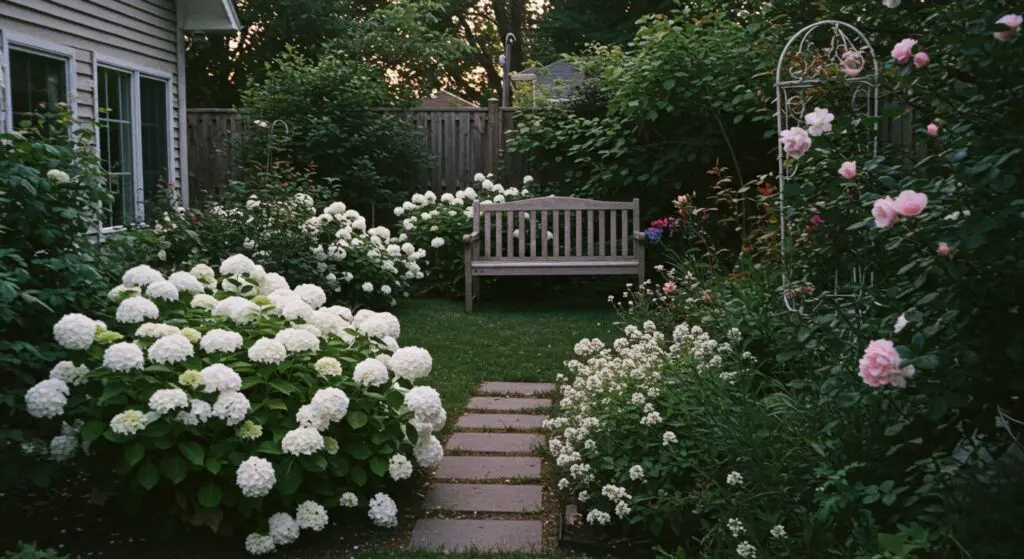
See? Creating a stunning white garden isn’t impossible. White gardens simple design principles focus on elegance. They use texture, form, and light. They don’t rely on a riot of color. That simplicity makes them achievable. It also makes them incredibly peaceful.
Remember, white doesn’t mean boring. It means intentional. It means refined. A well-planned outdoor gardens design white theme looks sophisticated and timeless. And it’s easier to maintain than you might think. Especially when you choose tough, low-maintenance plants.
Anyone can cultivate this kind of beauty. Whether you have a huge yard or just a few pots. Start small if you like. Experiment with plant combinations. Play with textures. Add simple styling touches. Most importantly, enjoy the process. Find joy in creating your own serene slice of white garden heaven. Go ahead, give it a try!
